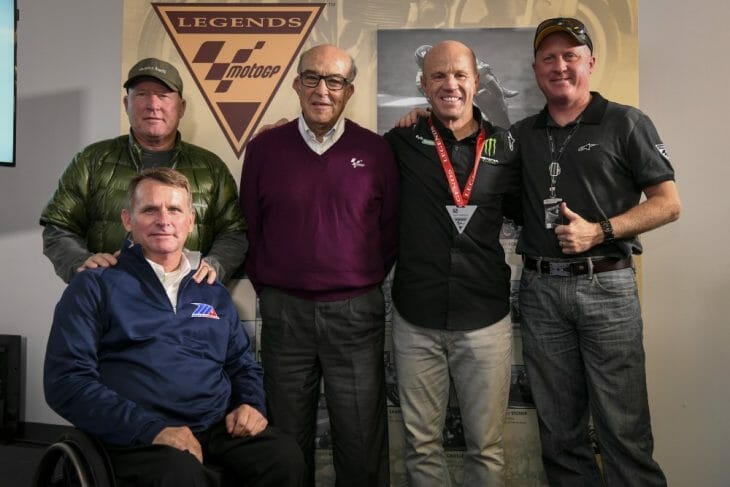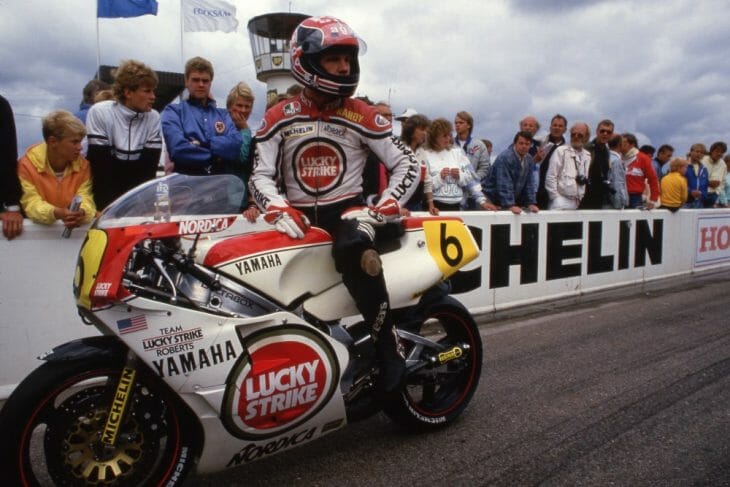Larry Lawrence | May 2, 2018
Archives: Legend Mamola
 Randy Mamola (wearing his MotoGP Legend medal) celebrates his induction into MotoGP Legends at COTA along with friends Kenny Roberts (in green), Wayne Rainey (in blue), Dorna’s Carmelo Ezpeleta (in purple) and Kenny Roberts Jr. (in gray).
Randy Mamola (wearing his MotoGP Legend medal) celebrates his induction into MotoGP Legends at COTA along with friends Kenny Roberts (in green), Wayne Rainey (in blue), Dorna’s Carmelo Ezpeleta (in purple) and Kenny Roberts Jr. (in gray).
When talking about his reaction to his good friend Wayne Rainey’s racing injury in 1993 that left him paralyzed, Randy Mamola choked up. But then came a response you’d come to expect from Mamola. In a letter he wrote to his buddy at the time, in a nutshell he said to Rainey, “I sure am glad you’re still here. You might not be able to walk, but by god I can talk to you, I can shake your hand, I can hug you.”
That’s just the way Mamola looks at life. He chooses to see the silver lining in almost any situation. And that approach has served him well. Here is a man who by all rights deserves to be a world champion. He was on the verge of winning the 500cc Motorcycle Grand Prix world title four times, yet instead of focusing on what might have been, Mamola celebrates what was. He looks at the wins, the great battles, the adulation from his fans, the camaraderie with his fellow racers and team members, being able to see the world and all the benefits a GP motorcycle racer enjoys and acknowledges that’s it was a privilege and a joy regardless of titles he did or did not attain.
Mamola was in California when he got the call that he was going to be honored as a MotoGP Legend during the U.S. round of the MotoGP Championship in Austin. It was the middle of the night. In the morning when he told his son Dakota about it, it was pure Mamola humor. His son walked into the room and Randy whispered “You’re looking at a legend.” “What?” Dakota demanded. “A legend. You’re looking at a legend.”
The stats are indeed impressive. The Northern Californian was crowned runner four times in the 500cc Motorcycle Grand Prix World Championships. When he retired from Grand Prix racing at the end of 1992, he’d earned a total of 13 wins and 57 rostrum finishes. He also won five poles and scored GP podiums in three different decades.
Perhaps even more important in the big picture, was the contributions Mamola made to society off the track and as a result helping to positively change the image of motorcyclists in the process.
Mamola spoke of his work with Two Wheels for Life, the official charity of MotoGP that works to save lives in Africa – using motorcycles.
“And I’ll mention Two Wheels for Life, which was Riders for Health. My trip, my donations, the help of the riders and everyone that did things to get it to that point…Princess Anne told me I had to go and see how it was being spent and me and Barry went to Somalia before the civil war…we now reach more than 15 million people using motorcycle. Besides my friends and family, the motorcycle is the hero in my life. It has given me and these Champions the passport to travel the world, to represent their country and/or brands and sponsors, in a sport that’s one of the greatest things people can watch or be a part of.”
Mamola got his start as a flat track racer in Northern California’s AMA District 36. His hero was Harley-Davidson factory racer Rex Beauchamp, who he named his dog after. Along the way he began road racing as well. His first international exposure was traveling to New Zealand as a 15-year-old and racing in the Marlboro Series where he was quickly recognized as a wunderkind, running with and often beating top riders, like Chas Mortimer, who was winning at the world championship level.
Then in 1979 a little-known Mamola was part of the underdog American squad that beat Great Britain in the Transatlantic Match Races. Mamola was the second leading scorer, topping even the great Barry Sheene on his home tracks. And keep in mind at this point Mamola had very little big bike experience. So it was really no surprise when Mamola, was an instant success when he began his GP career in ‘79. He scored his first podium in his second GP start. He even moved up later that very same year and managed a pair of podium in the 500cc class in his rookie season. To say Mamola was a hot property after that jaw-dropping 1979 season would be an understatement.
Even though Mamola had friends in guys like Kenny Roberts, Kel Carruthers and members of his crew, he was still a teenager away from home for the first time for a long stretch and he said at his parents’ house recently he discovered some letters he’d written home, and the loneliness in those was apparent.
In 1980, on the factory Heron Suzuki, Mamola was an instant title contender. His first GP win came at Zolder in Belgium.
“It’s funny because after I won that first GP I just sat there and thought, ‘Man, that wasn’t very hard,’” Mamola remembers. “It was just like any other race where maybe I podiumed, but this time I got the victory because maybe I outsmarted the other guy.”
That year Roberts was coming off two-consecutive 500cc GP world titles and was shooting for a third. Mamola says the relationship between him and Roberts didn’t change much, even though they were suddenly battling heads up for the world championship.
 Randy Mamola became a fan favorite during his time in Motorcycle Grand Prix racing. (Henny Ray Abrams photo)
Randy Mamola became a fan favorite during his time in Motorcycle Grand Prix racing. (Henny Ray Abrams photo)
“Looking back on it now, Kenny was Kenny and I was who I am,” Mamola explained. “It wasn’t like I had to hate him to want to beat him.”
In ‘81 Mamola battled Marco Lucchinelli down to the wire for the championship and again came up just short. His bike seized at a few key races, otherwise he would have won the title, but again Mamola looks back with a glass half full mentality.
“Even though I finished second to Lucchinelli, I beat Kenny in the championship and that was big to me.”
When Suzuki pulled out of racing at the end of 1983 Mamola was left without a ride. He said he practically had to beg Honda to give him a customer bike to compete in ‘84. When Spencer got hurt early in the year Honda gave the green light to Mamola’s effort. He finished runner up to Eddie Lawson that year in spite of missing the first two rounds of the series. In a remarkable performance, Mamola was on the podium in all but one of the races he competed. He looks back on that ‘84 championship second place as perhaps one of his proudest accomplishments.
“It was probably the most enjoyable,” Mamola says of ‘84. “As far as having your own team and mechanics.”
Mamola had one last really good shot at winning the championship in ‘87 with the Team Lucky Strike-Roberts squad. But that year Wayne Gardner caught fire on the Rothmans-Honda and won seven races en route to beating Mamola for the title.
“Wayne and I were a lot alike in many ways, in terms of riding on the edge, coming close to high-siding, stuff like that,” Mamola recalls. “Fortunately for Wayne, Honda got it right that year with that NSR500. I remember at Rijeka Wayne won and Eddie and I were on the podium with him and Wayne looks down at us and said, ‘That race was really close huh?’ And Eddie and I just looked at each other and grinned. Eddie and I would be battling up front and Wayne would just blow by us on the straights like we were sitting still. And he’s standing up there saying, ‘Man, we were so even!.’”
When Mamola took the Cagiva ride in ‘88, he knew his days of battling for the championship were over. So during those three years with the underfunded Italian maker Mamola took satisfaction in the small victories the team managed.
Then, after sitting out the ‘91 season, Mamola came back one more season with a Budweiser backed Roberts satellite squad. At Hungary that year he scored his final podium, giving him the distinction of podium results in three different decades.
At COTA when Mamola was honored, all weekend he talked about others. His mom and dad, his former managers, his mechanics, fellow competitors, his family and fans. Maybe that’s why Mamola seems so content as a career as perhaps the greatest GP rider to have never won the title. He understands the impact his career had on those around him.